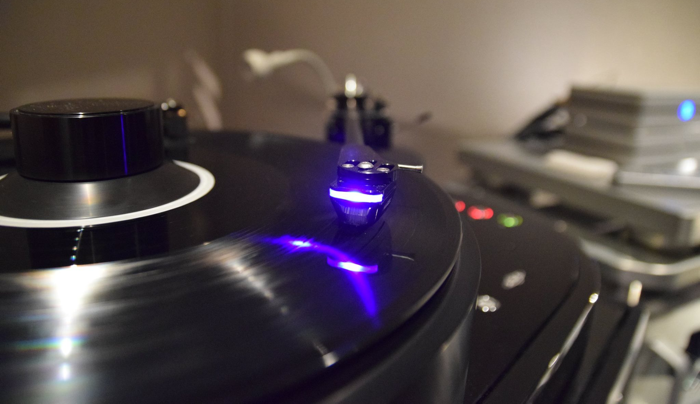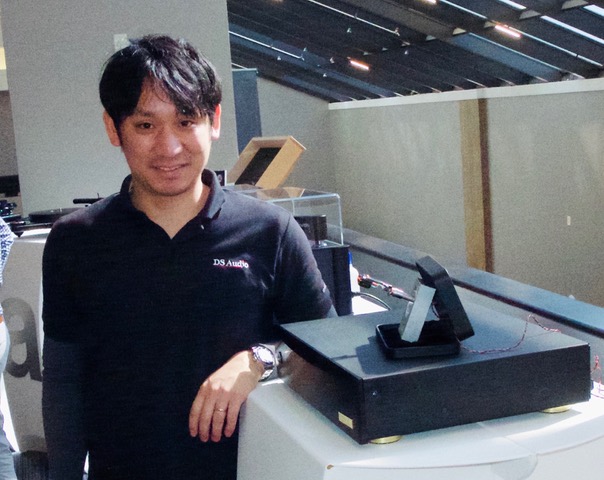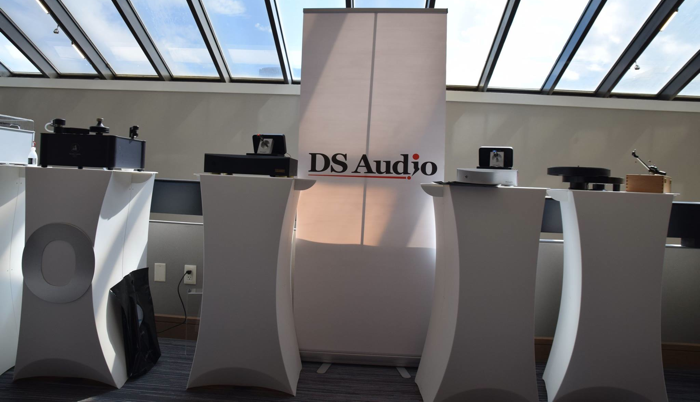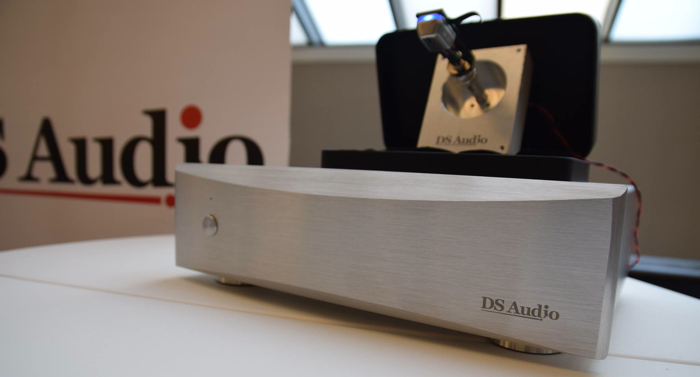
Jack has reviewed the DS Audio DS-W1 (in fact there was a Part 1 and Part 2), the DS Audio Master1, the DS Audio DS 002, and the DS Audio DS-W2 optical cartridges over the past few years, so we’ve had these cartridges playing in our system and are familiar with the company, but at RMAF in October, Jack and I, along with Mike Fajen, Customer Service Manager for Musical Surroundings, finally got to sit down for a long-anticipated interview with Tetsuaki Aoyagi, President of DS Audio.
Discovering Optical Cartridges
 When you meet Aki in person, like us you may be surprised at first by how young he is, but next you’ll probably be impressed by how passionate he is about the optical cartridges his company makes. Here’s the story he told us about how the cartridges and DS Audio came about.
When you meet Aki in person, like us you may be surprised at first by how young he is, but next you’ll probably be impressed by how passionate he is about the optical cartridges his company makes. Here’s the story he told us about how the cartridges and DS Audio came about.
“I like music,” he said, “but I never heard vinyl. I’m 32-years-old, so I’m not the age for vinyl. When I heard vinyl several years ago, it was the first time for me. My father took me to an audiophile event where I heard Michael Jackson’s Thriller on vinyl. It was impressive for me because the sound was much, much better than my iPodTM. I asked the guy playing the vinyl what makes it sound so good. He was using a Toshiba optical cartridge from 40 years ago. So, I asked him, What is it? The sound is so impressive.”
So now, here’s the second thing you need to know about Aki, his father, Tetuji Aoyagi, started Digital Stream Corporation30 years ago. “Our company is an optical development company, so we are good at optical development. That’s because we can make it,” Aki explained. Jack, Mike and I kind of got the feeling that while most of us may have grown up playing little league baseball, Aki’s playground was a world-class factory on the cutting edge of optical technology.
In fact, Digital Stream Corporation partnered with Microsoft 20 years ago to make the first optical mouse. They also make joysticks for gaming and optical technology for computer interfaces. DSC is also one of the world’s leading suppliers of industrial laser optics systems in the optical disc market, in medial testing systems and for various laser optical instruments. They have a market share of 95% in disc tester optics.
So, when Aki saw the Toshiba optical cartridge, he says he thought, “We can make it much better because we can use JVD (jet vapor deposition used in optical-development projects), and we know optical technologies much better.” The guy with the optical cartridge actually gave Aki a Toshiba cartridge to take home.
“The next day, I brought it back to my office, and I opened it. I was thinking, oh, we can make it much better.” As a goal, he made the first optical cartridge by himself. With his dad’s support and encouragement, this was the beginning of what is now DS Audio.
Early Optical Cartridge Designs
With the Toshiba cartridge, one of the first problems Aki discovered was overheating because the design used a lamp and there was no aerating. In fact this overheating problem has been an issue since Philco first introduced their optical cartridge, the “Beam of Light”, in the early 1940s, which used a simple, small light bulb that shone on a small mirror that attached to the stylus. The modulations of the needle in the record grooves were translated into light modulation on a photo-electric cell.
Aki says LED is the main technology that makes DS Audio’s optical cartridges so much better than the early models from Toshiba and others. “We could place the LED much closer to the shutter to eliminate the heat issue,” he said. “The cantilever is moving and making a light or a shadow behind it, which the optical sensor reads. Because the LED is not a heat source, it can be positioned very close to the shutter. This means that the shadow that is being read is much more precise because it is so close.” The LED is even closer to the needle with the newer 002 and the Master1 versions of their optical cartridges. “Originally the shutter position was behind the cartridge suspension. With the newer models, the position is closer to the needle,” he added.

A full line up of DS Audio optical cartridges were on display at RMAF 2018.
Manufacturing Process
Another question we asked Aki was who did he get the knowledge to make the cantilever, the stylus and what he calls “the rubber”? While Namiki (Adamant Namiki Precision Jewel Col, Ltd.) makes the stylus and the cantilever, the cartridges are built in house. ”I actually went to different guys who make cartridges and asked them how they make them. There were many Japanese pioneers and good people who were willing to tell me what they knew. They are old, but they are happy to join such young people to get our product to market. Seven years ago, it was me and just one other guy [at DS Audio] that started making optical cartridges. Now I am going so many places, I’m no longer making the cartridges, but there is a production department who are making cartridges.”
The electronics for the cartridges are also done in house, but it’s an interesting story. Aki says he found someone who used to make optical cartridges for Toshiba. “He believed that the equalizer for Toshiba’s optical cartridge was not so good. He made (a new version) for himself and improved it a lot. Fortunately, we have a relationship with him, and I asked him to join the DS Audio project because I want to make optical cartridges again. He is now helping build each of these optical cartridges.”

A closer look at an optical cartridge mounted in a tonearm.
Public Response
Before wrapping up the interview, we wanted to know what people say when they first hear an optical cartridge and what kind of reception has there been for the cartridge worldwide. Aki said that first of all everyone is interested and wants to know what it is. “Many people are confused and think that our cartridge is digital. No, our cartridge is pure analog, and this is a big misunderstanding.”
Mike Fajen volunteered, “From my experience, the sonic impact is always impressing people and blowing them away. My description of what I heard when I first heard an optical cartridge was almost like seeing HDTV for the first time. I didn’t realize what I was missing until I saw it, and I think of the optical cartridge as ‘high-definition’ analog. And sort of in the progression from moving magnet to moving coil you reduced your mass and increased your detail retrieval capability. I feel like this is the next step in that progression with even lower mass and no magnetic structure whatsoever.”
Jack added, “My first impression was that this [the optical cartridge] sounds more like really, really good reel-to-reel tape because it doesn’t have the vibrations that you hear from the magnets in a moving coil as it encounters resistances. To me, this is a much bigger step forward than the strain gauge was.”
Future Plans
We wanted to know what Aki sees in the future for DS Audio. He explained that a big goal is to make optical cartridges more mainstream. “It is now a very unique cartridge. I want an optical cartridge that is more mainstream and affordable. It is a big challenge for us. Now moving coil cartridges are more popular, but I believe optical cartridges are the next generation cartridges. That is a big step.”
Another project possibly in the works is to develop a mono optical cartridge. Their optical cartridges now have two optical sensors since they are stereo. Aki says, “Some customers are asking me for it, so I’m thinking to develop a mono cartridge. The mono cartridge and stereo cartridge design is totally different. We will need a totally new design, so it takes time. First, we want to make our lineup complete and introduce an optical cartridge at a much more affordable price point. And then we might look at mono.”
“In Japan, we are still doing a five-year marketing plan. And, in Japan, many people know about the optical cartridge from 40 years ago, “ Aki added. Jack agreed that in the US, people don’t know about optical cartridges and confuse them with a Japanese laser turntable that didn’t work very well.” In fact, Garth Leerer, owner of Musical Surroundings didn’t meet Aki through Japanese or U.S. contacts. The Australian distributor for Musical Surroundings made that introduction after favorable impressions hearing the first DS Audio optical cartridge at the Hong Kong High End show.
Concluding the interview, Aki said, “I have traveled all over the world and every customer has two things they ask.” So we promised to include these questions and the answers in our interview:
- Is it analog? And the answer is yes.
- Is there a needle? Yes, there is a needle.
Thanks for the interview, Aki, and keep doing what you’re doing. We can’t wait to hear the DS E1, the next step forward for DS Audio optical cartridges available in January! And, for those of you who are reading this, if you haven’t heard an optical cartridge from DS Audio, I highly recommend that you find a chance to listen to one. They very well may be the next-generation cartridges we’ll all enjoy one day.

Hi, An interesting piece on DS. My vinyl collection has lain idyll since I moved to CDs in 1984 in particular because I always hated the background pops associated with vinyl no matter how scrupulous in care and cleaning.
However, your article does not make explicit reference to the absence of such background sounds which I have seen elsewhere (HFN, 4/19) Is this just taken for granted or is it not universally recognized as a USP?
Any suggestions as to where a DS-E1 might be heard in (the North if possible) Scotland?
many thanks
Thanks for your comment. We will try to get an answer for you on where you can hear the optical cartridge in Scotland.